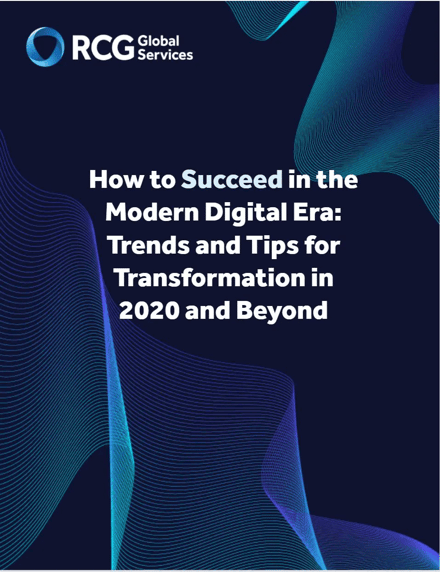How to Succeed in the Modern Digital Era: Trends and Tips for Transformation
In 2020 new demands will be placed on businesses looking to keep pace with transformation trends. But how do you succeed at digital transformation when the goalposts are constantly shifting?
Transformation involves change

Companies going through the digital transformation process — and, at this point, it could be argued that all companies should be going through that process — are likely to experience considerable degrees of difficulty and discomfort.
And that begs an obvious question: Why should companies put themselves through a transformational process that is likely to be both difficult and uncomfortable?
It’s a fair question. But it’s a question with a very simple answer…
Change or Die: Is it really that simple?

Business Insider reported that John Chambers, who served as Cisco’s CEO for 20 years, predicted the demise of many companies that fail to digitally transform. “Forty percent of businesses in this room, unfortunately, will not exist in a meaningful way in 10 years,” Chambers prognosticated in a keynote speech. The only companies that will survive, Chambers believes, are those that successfully transform digitally — though he expects that many will fail in the effort to transform. 1
A Gartner survey has found that nearly ninety percent of senior business leaders now believe that digitization is a priority, and, for many companies, a do-or-die undertaking. 2 TechRepublic recently reported that 80% of IT professionals surveyed across 35 countries believe digital transformation to be essential to business survival. 3
And Brand Quarterly, in a 2019 article titled “Evolve Or Die: Why Digital Transformation Is More Important Than Ever,” succinctly sums the importance of digital transformation: “Quite simply, if your organization is not modernizing then you’ll be left behind, and the threat of disruption becomes very real.” 4
Given the importance of digital transformation, it’s no surprise that it has become a standard component of the global business lexicon. It’s also no surprise that most organizations are actively working to digitally transform — at least to some degree. MuleSoft’s Connectivity Benchmark survey found that 97% of IT decision-makers are involved in digital transformation initiatives. And yet, the same survey found that nearly 9 of 10 businesses have stalled in the process, largely as a result of integration challenges. 5
How can you evaluate your organization’s digital transformation progress to ensure that you’ll be on target in meeting the challenges of the future? Three of the world’s foremost information technology analyst and advisory firms have offered some detailed guidance. Forrester, Gartner, and IDC have each published some near-term predictions that you can use for evaluating whether your transformation efforts are in line with the demands that will be placed upon organization in 2020. And MuleSoft, a Gartner Magic Quadrant Leader, has identified the top digital transformation trends for 2020.
Forrester Emphasizes the Importance of Adaptability In 2020

The ability to recognize and capitalize upon opportunities of all sizes will also be key to success. “Factors including heightened values-based consumer activism; the lack of clarity around Brexit; automation, Artificial Intelligence (AI) and robotics moving deeper into the organization; and recessionary fears due to sociopolitical uncertainty will make 2020 a raucous year, forcing leaders to embrace adaptability.”
Forrester’s specific predictions for 2020 include:
- The importance of keeping it real. As consumers search for deeper meaning, companies will need to focus carefully on providing authenticity.
- Providing true customer value will be key.
- Business leadership, particularly CIOs, will focus more on developing enhanced relationships with employees.
- 2020 will be the year in which immersive, adaptive IT will become far more prevalent.
- Companies that have achieved a degree of success with CX will gather momentum, while many that have failed to attain substantial success will cut spending on CX programs.
- More progressive firms will double their spending on data strategy. And many companies will receive painful reminders about the importance of getting data right.
- Ransomware incidents will increase as data and AI become weaponized.
- For many organizations, personalization will give way to group-targeted experiences, particularly in marketing.
- The workforce will be transformed through automation, impacting job markets and global economics.
- Regulation will provide a boost to some markets, while destroying others. And the rate of regulation will increase in 2020.
Gartner Predicts the Top 10 Strategic Tech Trends for 2020

What is a strategic technology trend? According to Gartner, it’s a trend that provides significant disruptive potential and is beginning to exhibit indications of broader impact and use or a trend that is demonstrating volatile growth.
Trends are evaluated largely upon their people-centric impacts. “Putting people at the center of your technology strategy highlights one of the most important aspects of technology — how it impacts customers, employees, business partners, society or other key initiatives,” said Gartner VP David Cearley. “Arguably all actions of the organization can be attributed to how it impacts these individuals and groups either directly or indirectly. This is a people-centric approach.”
The symposium identified 10 strategic technology trends for 2020:
- Hyper automation. A combo of machine learning software and automation tools, hyperautomation refers to all steps of the automation process.
- Multiexperience. During the next several years, users are likely to experience significant changes in how they interact with the digital world. These changes will occur through increased implementations of conversational platforms, virtual reality, augmented reality, and mixed reality.
- Democratization of Expertise. Democratization focuses upon providing technical expertise to people independent of their own expertise. Gartner predicts that the democratization trend will surge in four key areas through 2023:
- Democratization of data and analytics
- Democratization of development
- Democratization of design
- Democratization of knowledge
- Human Augmentation. How can technology deliver both physical and cognitive improvements to the human experience? That’s the focus of human augmentation. Gartner expects that during the next decade the evolution of human augmentation will lead to more individuals seeking enhancements.
- Transparency and Traceability. Protecting the personal information of consumers will become increasingly important. Transparency and traceability support a range of corporate and governmental initiatives designed to help restore eroding consumer trust in the companies that serve them.
- The Empowered Edge. Edge computing locates content collection and delivery closer to repositories, consumers, and generators of content.
- Distributed Cloud. More cloud services will be distributed to multiple locations. Gartner predicts a new age in cloud computing as the now-dominant centralized model shifts more toward a distributed model.
- Autonomous Things. Tools and devices powered by AI to replace functions traditionally performed by humans: those are autonomous things (think drones, robots, self-driving vehicles, etc.).
- Practical Blockchain. Though blockchain management has evolved little for most organizations, Gartner anticipates that will change. “Blockchain remains immature for enterprise deployments due to a range of technical issues including poor scalability and interoperability,” said Brian Burke, Gartner Research VP. “Despite these challenges, the significant potential for disruption and revenue generation means organizations should begin evaluating blockchain, even if they don’t anticipate aggressive adoption of the technologies in the near term.”
- AI Security. While hyper automation and autonomous things will offer great opportunities for transformation, significant new challenges will also arise in maintaining and enhancing security. Gartner recommends a three-fold focus going forward:
- Protecting AI-powered systems
- Leveraging AI in boosting security defenses
- Maintaining vigilance against the likely use of AI by attackers
IDC Foresees a Need for Leveraging More Outside Help

IDC does not see that trend reversing near term. In fact, over the next five years IDC expects the skills gap to widen, with companies seeking to leverage more outside help in bridging that gap.
But bridging the skills gap with outside help presupposes that the outside firm providing the help is qualified to do so. And that makes the vetting of outside vendors a very critical process. When assessing the competence and capabilities of outside help, IDC has provided a list of four skillsets that should be areas of focus:
- Expertise in the use of analytics, intelligent automation, and service delivery platforms
- An in-depth understanding of lines-of-business needs along with key internal functions (HR, for example)
- Experience and expertise in facilitating change management (must also be proficient in managing the impact of change upon an organization’s workforce)
- A demonstrated ability to leverage the ever-expanding capabilities of IT into enterprise-specific operational technology
IDC has also provided ten worldwide services predictions for 2020:
- Financial impact of a widening skills gap. By 2022, the global impact of the IT skills gap will more than double from 2019’s $302 billion to $775 billion. Much of that massive increase will stem from reduced revenue and increased costs resulting from delayed product releases.
- The adoption of DX-enabled processes. Three-fourths of IT organizations will transform processes to be compatible with DX-enabled processes. By 2022, four of five processes and 90% of IT employees are expected to be impacted by this transformation.
- A mix of non-AI and AI-enabled automation. Nearly half of all services received by 2023 will be delivered by a mix of both AI and non-AI. AI-enabled automation will likely represent one-fifth of all spending on automation.
- Innovation at scale. Organization-wide innovation-at-scale strategies will be implemented by 25% of organizations by 2023.
- Most companies will partner with tech services vendors. Nearly 80% of organizations will be partnering with technology services vendors by 2022. Services vendors will be tasked with synchronizing multiple technologies to serve various business use cases, driving large-scale transformation.
- Legacy mainframe applications modernization. By 2024, more than half of organizations are expected to have modernized mainframe applications in support of updating application infrastructure. Most are expected to utilize the cloud in supporting these modernization efforts.
- Hanging on to employees. More than 40% of organizations are expected to invest in improving employee onboarding systems. Most will be working toward the goal of substantially improving employee engagement/retention — as much as 89%.
- More outsourced parts. Talent shortages and shrinking budgets will force the outsourcing of more components of product lifecycle functions. By 2025, as much as 75% of tech product companies will be outsourcing much — or even all — parts of lifecycle functions.
- New services sought. The adoption of new services from 3rd platform solutions will push service business to reskill 20% of their workforces.
- IoT spend. More than $10 billion annually will be spent by IT organizations by 2025 in deploying and maintaining Internet of Things devices.
MuleSoft Has Identified 7 Key Digital Transformation Trends for 2020

- Connecting the consumer experience. Digital transformation initiatives are largely driven by consumer experience. The importance of the consumer experience is well understood by both consumers and the companies that serve them. Nearly two-thirds of consumers say that a disconnected consumer experience would prompt them to consider leaving the company providing that poor experience. And more than 90% of business leaders agree that delivering a quality consumer experience is key to their company’s near-term success.
- Data-driven business. The gathering, storage, and processing of data is crucial to every business organization. But many companies are experiencing significant problems in maximizing the value of data. More than 80% of IT decision-makers report that the proliferation of data siloes within their organizations are creating significant business challenges. The best-run companies are actively working to break down data silos, seeking to enable improved customer services, more streamlined operations, and an enhanced ability to rapidly launch new products and services.
- Artificial intelligence and machine learning. Artificial intelligence has proven to be an effective tool for achieving many business goals. Already, machine learning and basic task automation technologies have been deployed by more than half of all business organizations. And more than a third currently use virtual agents or chatbots. The use of autonomous robots and drones is also rapidly increasing. At many companies, automation helps to drive faster, more accurate decision making.
- Multi-cloud computing. Among companies with 1,000 or more employees, more than 80% are already using multi-cloud environments. Why? Flexibility is a key driver in the adoption of multiple cloud platforms. Most organizations have found that there is simply no single cloud platform that’s able to meet all of their workload needs. But the use of multiple cloud platforms can come with some problems. Multi-cloud platforms are more complicated to manage and can pose some unique security issues.
- Partnering with IT. The efficiency of any organization’s IT department is integral to the success of that organization. But in recent years IT departments have been under unprecedented pressure to deliver more, faster. Only 36% of IT decision-makers report that they are able to complete all of the projects assigned to them. And more than two-thirds report that virtually all of their time is spent simply keeping afloat, with little or no time available for innovating. And yet, IT drives digital transformation initiatives at the best-run companies.
- Co-creating value with external stakeholders. Many companies have found that reaching out to partners in building a broader digital ecosystem enhances their ability to weather disruptions from new technologies and competitors. In 2020, it’s likely that the most successful enterprises will be those that build and deploy a network of collaborative ecosystems comprised of external stakeholders such as customers and partners.
- Boosting business performance with APIs. It’s no coincidence that organizations owning public and/or private APIs report experiencing beneficial business outcomes. Roughly half of all companies report that they have increased both productivity and innovation through the use of APIs. Many have leveraged APIs for substantial revenue growth.
RCG’s Top 7 Tips for Successful Digital Transformation in 2020

As an organization very experienced in applying our focused expertise to helping companies achieve their digital transformation goals, we’ve learned a great deal about how to successfully transform. We’ve distilled knowledge we’ve gained through our real-world experience with client companies all around the globe into the seven following tips that you can use to streamline your journey to successful digital transformation in 2020 and beyond.
1. Establish a Living Digital Strategy.
Your Digital Strategy should be developed using an agile approach that leverages a cross-functional team with a proven results-driven process. It should be based on an understanding of the current business model, related business processes, and applications. The result should include an actionable, scalable transformation plan to reach identified business results.
Focus on achieving your business goals by defining, prioritizing, and architecting processes, applications, and technologies. RCG strategy teams, for example, typically focus on the delivery of three customized digital business roadmap approaches:
- A directionally correct strategy that addresses “Where should I start?” this approach is useful for justifying an existing strategy and planning the supporting budget.
- Identification of opportunities and options for our clients that say, “Show me the possibilities, I’ll pick the path.” This approach is typically useful for use case identification and analysis of options.
- A guided journey that addresses the full digital transformation journey and solution. It is our holistic approach for clients who wish to define the goal and get there via the optimal route.
Beginning the journey with the end in sight is critical, and that is why you begin with business goals at the forefront of your strategic plan. Understanding current capabilities and gaps are crucial, and this isn’t something most organizations should self-assess — an outside viewpoint can be quite enlightening. Creating fast implementation cycles for selected priorities helps you quickly prove (or disprove) impact. Then you can scale the successful projects in a prioritized fashion.
2. Design for Exceptional User Experiences
Forrester’s 2020 predictions focus heavily on adaptability and providing true value to your customers. Digital platforms are typically focused on the customer experience — the X. And the customer experience should be driving business decisions at the executive level. Your customers are dictating what they expect from you and how they want you to behave — even if they deliver that message through their decision to no longer be your customer.
The level of personalization required to deliver stellar customer experiences requires more than a refined technical architecture. New and updated applications should focus on creating comfortable, intuitive, and engaging points of entry for workers and customers.
The challenge facing many companies today is that workers and customers come to applications with high expectations. They expect applications to be intuitive and easy to use. And, unfortunately, the most sophisticated systems and toolsets designed to date won’t set apart a web or mobile app in the market and drive greater impacts
if the user experience is cumbersome. That’s why you need new skills in your design teams.
The first plank in your design philosophy platform should be empathy. Effective people-centric solutions are created by technologists who have emotional intelligence — people with strong empathy skills. As noted above by Gartner’s David Cearley, deploying a people-centric approach is crucial to success.
Though most companies possess extremely qualified technology organizations, most IT departments are limited in bandwidth and talent to “run the business” missions. But transformation requires different skill sets. Too often businesses view digital transformation as a technology change, when, in fact, it is a business change. It often requires the viewpoint of an outside organization to help leaders understand that transformation is a business change, and that business leaders must be an integral part of that process.
3. Harness Digital Data Engineering
As we noted in a recent blog post, “Successful digital engagement requires understanding
and adapting quickly to the new behaviors and expectations of digital users. Their digital experiences require enterprise data, analytics, and applications to adapt to real-time digital processing — an adaptation that requires a next-generation, enterprise digital data architecture.”
How crucial is it that companies invest in data analytics? A recent Forbes article put it quite bluntly: “Companies that still aren’t investing heavily in analytics by 2020 probably won’t be in business in 2021. There is simply far too much valuable customer data to be collected, processed and turned into insights for any company to remain competitive without making full use of modern analytics tools.” 10
Modern data engineering provides a foundation for developing data ready to be used without any additional preparation or manipulation supporting many different data types, analytic use cases, machine learning, advanced analytics, and more with data lake curation for managing data in a data lake.
To achieve a modern data architecture that is a suitable foundation for advanced analytics with
AI and machine learning, start with an advanced analytics strategy that provides the roadmap to realizing business value from data and analytics and identifies additional opportunities to make use of advanced and automated analytics operating on data lakes.
4. Apply Intelligent Innovation
We all have available to us more fantastical technological tools than at any time in human history. But tools such as AI are of little value if they are not used — particularly when many of your competitors are sure to put those tools to good use. One example we noted in a recent blog post is the use of AI in eclipsing the potential of traditional CRM.
The ability to be intelligently innovative in the use of the modern tools of technology are integral to successfully achieving digital transformation. (We believe that our proven ability to intelligently innovate is among the most important — and unique — of the many skill sets we bring to our clients.)
Progressive organizations value the quality of advanced analytics and AI solutions for their performance as well as their ability to drive ROI, customer satisfaction, and contributions to strategic goals. With Intelligent Innovation, companies realize measurable benefits:
- Reduce time to market for new products and services
- Increase the productivity of people and processes
- Acquire new technology skills more quickly
- Improve knowledge management & resilience
- Optimize costs & use of resources
- Gain a competitive advantage
- Establish momentum and move the needle
5. Aim for the Clouds
The future for most companies lies in the clouds. IDC predicts that 90% of Enterprises will use multi-clouds in 2020 and McKinsey expects cloud-specific spending to increase more than six times faster than all other IT spending this year. Given these massive adoption trends, having a 20/20 vision (literally) while you soar to the cloud is essential to avoid getting ‘burnt’ due to cost overrun, security, and compliance challenges in the cloud. Gartner predicts that in 2020, organizations will rethink their operations for multi-cloud and distributed cloud. 11
Since the large cloud providers have evolved into technology eco-systems, enterprises must re-evaluate the key success factors for the cloud era:
- Do you have developers that understand the cloud?
- Do you have people that know how to operate it?
Most large enterprises may have different ‘slopes’ in their intended cloud adoption curve and their in-house team’s learning curves. So, it is critical to partner with the right MSP to bridge that gap to ensure cloud success.
The primary drivers of cloud transformations are typically the agility and speed in building modern, digital platforms. A common mistake we often see companies making with their cloud migrations is taking Security often as an afterthought. (Our whitepaper on cloud security explores the oft-overlooked considerations for keeping data safe in the cloud). Security must get a front-row seat in the cloud journey to avoid costly incident remediation and architectural re-vamp.
6. Scale to Just Enough Quality
According to the World Quality Report 2019-2020, quality is now a key driver in growing businesses and improving business outcomes. And yet the share of budget typically allocated to QE has continued to decline.12
Organizations can’t seem to figure out how to manage software quality and testing for Agile and DevOps delivery. Should it fully align to scrum teams or squads or an independent department? How much test coverage should be the goal? How much automation is ideal?
Quality Engineering should not be the resource drain it was once considered as. In fact, better quality is proven by lower total operations cost along with better customer sentiment. If the cost of quality still outweighs its supposed benefits, then the approach is not lean enough or is not targeting the right risk areas. Robotic process automation (RPA), AI, and machine learning for testing have advanced in recent years, and enable efficiencies never seen before. Organizations should invest and strategize in these technologies to build smarter, more impactful quality frameworks. Leaders should use quality engineering and testing data to inform product decisions from a risk standpoint.
7. Build Sustainable Systems
Organizations have spent years and billions of dollars creating the systems that support business operations. But inevitably, changes are made, and in many cases, functionality becomes obsolete, or there is a high level of functional and data redundancy. While these legacy systems are valuable, their processes and underlying technology may be reaching a point where they are unsupportable.
DevOps and Continuous Integration & Deployment (CI/CD) are both approaches that unify the development lifecycle, provide a framework for constant change, and support the design and building of more sustainable systems.
The key focus of modern application development is the user experience; it needs to be exceptional and encourage interaction with ease of use, useful and accessible features, outstanding performance, and simple flows. The focus on user experience is built upon a foundation of stringent security that not only complies with current regulations but also makes users comfortable sharing personal information. Modern applications take advantage of RPA and AI by providing automated processes to streamline operations resulting in contented users as well as cost and time savings. Finally, user experience, focused, modern applications provide users the ability to configure and adapt the apps to meet their needs.
Is Your Company Ready for 2020?

Are your company’s transformation initiatives in sync with all the tips and guidelines for 2020 listed above?
While those may seem like simple questions, they really aren’t. In fact, those questions can be incredibly difficult to answer for internal associates. It often requires a fresh view from the outside to develop an accurate understanding of your current transformation status, and for devising a plan for 2020 and beyond.
At RCG Global Services, we provide that external viewpoint that can be so critical. We also provide the many varied and ever-evolving skillsets that are essential to successfully achieving digital transformation — and that so many companies lack internally.
Works Cited:
1. https://www.businessinsider.com/chambers-40-of-companies-are-dying-2015-6
2. https://hbr.org/sponsored/2018/11/every-organizational-function-needs-to-work-on-digital-transformation
3. https://www.techrepublic.com/article/digital-transformation-critical-for-business-survival-4-out-of-5-it-pros-say/
4. https://www.brandquarterly.com/evolve-die-digital-transformation-important-ever
5. https://www.mulesoft.com/press-center/technology-trends-2019-connectivity-benchmark
6. https://go.forrester.com/press-newsroom/forrester-releases-2020-predictions/
7. https://www.gartner.com/en/newsroom/press-releases/2019-10-21-gartner-identifies-the-top-10-strategic-technology-trends-for-2020
8. https://blogs.idc.com/2019/11/18/idcs-top-10-worldwide-services-2020-predictions/
9. https://www.mulesoft.com/lp/reports/top-digital-transformation-trends-2020
10. https://www.forbes.com/sites/danielnewman/2019/07/14/top-10-digital-transformation-trends-for-2020/#1428289876be
11. https://www.mckinsey.com/business-functions/mckinsey-digital/our-insights/cloud-adoption-to-accelerate-it-modernization
12. https://techbeacon.com/app-dev-testing/world-quality-report-2019-2020-quality-now-key-driver-business-growth
Download a PDF version of this guide by filling out this form


